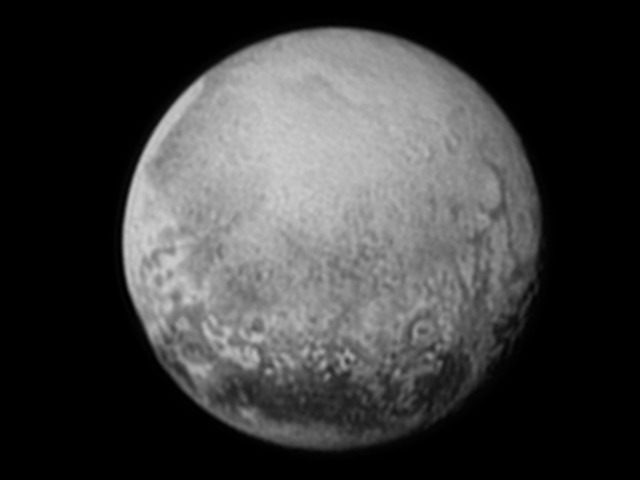Pluto has been demoted from planetary status – still a somewhat controversial decision, as the Associated Press observes – but the coming close pass by NASA’s New Horizons probe is still being celebrated as the conclusion of the space agency’s fifty-year quest to visit every planet in the Solar System.
Spectacular views from the lonely ice cube at the far edge of our stellar neighborhood are promised:
New Horizons has traveled 3 billion miles over 9½ years to get to this historic point. The fastest spacecraft ever launched, it carries the most powerful suite of science instruments ever sent on a scouting and reconnaissance mission of a new, unfamiliar world.
Guarantees principal scientist Alan Stern, “We’re going to knock your socks off.”
The size of a baby grand piano, the spacecraft will come closest to Pluto on Tuesday morning — at 7:49 a.m. EDT. That’s when New Horizons is predicted to pass within 7,767 miles of Pluto. Fourteen minutes later, the spacecraft will zoom within 17,931 miles of Charon, Pluto’s jumbo moon.
Sorry, Pluto, but not even having a moon (actually five moons) of your own gets you into the planet club these days.
The sneak peeks of Pluto in recent weeks are getting “juicier and juicier,” says Johns Hopkins project scientist Hal Weaver. “The science team is just drooling over these pictures.”
The Hubble Space Telescope previously captured the best pictures of Pluto. If the pixelated blobs of pictures had been of Earth, though, not even the continents would have been visible.
The New Horizons team is turning “a point of light into a planet,” Stern says.
An image released last week shows a copper-colored Pluto bearing, a large, bright spot in the shape of a heart.
When the probe gets closer, maybe we’ll discover Pluto’s heart is broken, because we don’t call it a planet any more. Have we tried asking Pluto if it identifies as a planet? Why aren’t we more concerned about making it feel unsafe with exclusionary astro-normative trigger language?
The big show depends on some fairly precise targeting to get the probe into that sweet spot, less than 8,000 miles from Pluto, for the best possible pictures. (The flight plan was laid in long ago – at this point, it takes more than four and a half hours for signals from the spacecraft to reach Earth, so all of its maneuvers are executed by pre-programmed on-board computers.) NASA seems confident New Horizons will deliver, and the results will be very different from the impression formed by terrestrial telescope observations:
Scientists involved in the $700 million effort want to get a good look at Pluto and Charon, and get a handle on their surfaces and chemical composition. They also plan to measure the temperature and pressure in Pluto’s nitrogen-rich atmosphere and determine how much gas is escaping into space. Temperatures can plunge to nearly minus-400 degrees.
Bill McKinnon, a New Horizons team member from Washington University in St. Louis, Missouri, expects to see craters and possible volcanic remnants. A liquid ocean and a rocky core may lie beneath the icy shell.
“Anybody who thinks that when we go to Pluto, we’re going to find cold, dead ice balls is in for a rude shock,” McKinnon says. “I’m really hoping to see a very active and dynamic world.”
In a lovely gesture, some ashes from Clyde Tombaugh, the man who discovered Pluto in 1930, are aboard the New Horizons craft, and his now-elderly children will be on hand at Johns Hopkins as the probe arrives. “I think my dad would be thrilled with the New Horizons,” his daughter Annette Tombaugh-Sitze was quoted by Yahoo News. “When he looked at Pluto, it was just a speck of light.”
The Pluto encounter is billed as, most likely, the last voyage of planetary discovery for any living human, although it is hoped that New Horizons will pass a few more interesting bits of Solar System flotsam on its way into deep space – unless, as the Washington Post warns, it hits some unseen bit of rock floating in space near Pluto, with even a tiny speck of dust posing a mortal threat to a spacecraft moving at 31,000 miles per hour. The risk of such an impact is considered extremely remote, on the order of 1 in 10,000.
In addition to that heart-shaped bright spot, scientists are interested in what appears to be a huge meteor or asteroid impact crater on Pluto, as well as a massive canyon and mysterious dark polar mass on Charon. It will take a year for all of the relevant data to be relayed by New Horizons, but humans should have a few good pictures to moon over (pardon the pun) by Wednesday. The official NASA webpage for New Horizons, complete with a countdown clock for the beginning of the close approach, can be found here.

COMMENTS
Please let us know if you're having issues with commenting.